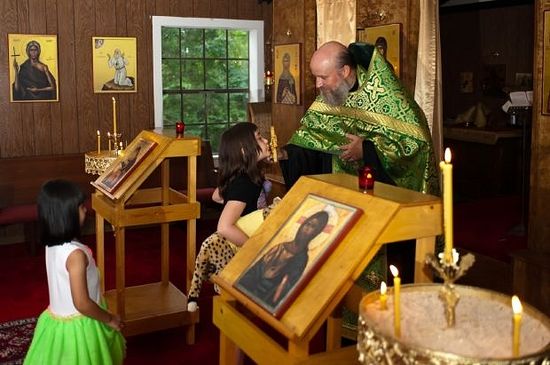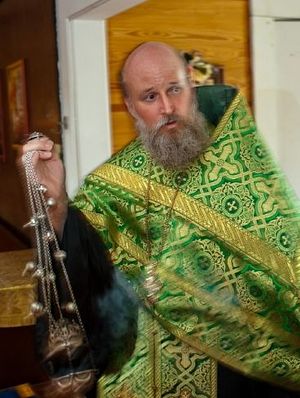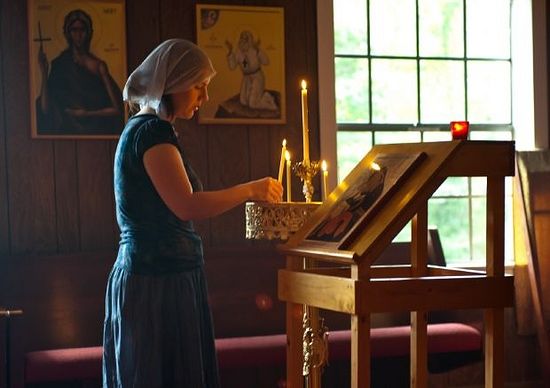SOURCE: News-Journal.com
By Angela Ward award@news-journal.com
TYLER — Ask most East Texans about the major divisions of Christianity and their response will probably mention only two of the three: Roman Catholics and Protestants.
 |
The third branch of Christianity, Eastern Orthodox, is relatively unknown in most of the southern United States, but that’s beginning to change.
The Rev. John Mikita, pastor of St. John of Damascus Orthodox Church in Tyler, said his congregation has slowly but steadily increased since it began six years ago. It now contains about 55 members.
“While our members include some people — mainly immigrants — who were raised as Orthodox Christians, most are native East Texans who converted to this branch of Christianity because they found it met their needs and answered their questions,” Mikita said.
Mikita himself began his vocation as an Anglican priest in Pennsylvania. While in seminary, he began studying Eastern Orthodox Christianity and, shortly after he was ordained, decided it was the branch that most fully and faithfully followed the teachings of Christ.
“Orthodox Christians have a different world view than either Protestants or Catholics,” Mikita said. “It’s not just that they arrive at different answers, but that they ask different questions.”
Protestantism and Catholicism are both rooted in Western culture, he said. Orthodox Christianity, which is most common in Asia and eastern Europe, tends to take a more oriental, mystical approach toward faith.
“The Orthodox liturgy is very different than anything in the West, either Catholic or Protestant,” Mikita said. “It’s very ancient and really rooted in a living past and living present.”
Mikita said the Protestant reformation was a response to the excesses and abuses of the Roman Catholic Church of the late middle ages. He believes that if western Europeans of that era had had access to the teachings and practices of Orthodox Christianity, they might have chosen that direction rather than forming a third branch of Christianity. However at that point in history, there was little knowledge of Orthodox Christianity outside of Asia, north Africa and the far-eastern portions of Europe.
“Becoming an Orthodox Christian is not an easy thing to do,” Mikita said. “We want to make sure that people are making this decision with their heads, as well as their hearts.”
 |
“My family was very supportive because, for me, it was almost returning full circle to the family’s original faith,” Mikita said. “My great-grandparents were Orthodox Christians, but my grandfather converted to Catholicism when he married a Roman Catholic.”
Mikita wears a full beard, which is traditional for Orthodox priests. Unlike Catholic priests, Orthodox priests can be married and he is; he and his wife, Christina, have two children. However, Orthodox bishops must be celibate and should Mikita’s wife die, he would not be allowed to remarry.
“A lot of people think I’m Jewish or Muslim,” Mikita said. “They’re often surprised when they realize the Christian world is much larger than they’ve ever been told.”
Eastern Orthodox Christians often come from a part of the world where they’re persecuted for their faith, but that has led to a strong internal cohesion in the Orthodox churches throughout the world, he said.
Harvey and Xenia Durham are Longview residents who are happy to have a relatively nearby Orthodox church to attend. Xenia Durham is a cradle Orthodox Christian, while her husband converted several years after they were married.
“Three of my four grandparents were immigrants and I was raised mostly on Air Force bases, where Orthodox Christianity wasn’t as rare as it is in East Texas,” she said.
Harvey Durham, who served for many years as the band director for Longview High School, said he was raised as a Baptist.
“It wasn’t a huge issue for my family when I became Orthodox,” Durham said. “I appreciate the Christian background and basic beliefs I learned growing up Baptist, but this branch of Christianity is the one I feel most comfortable with.”
Xenia Durham said the Orthodox services and foundational beliefs have not changed in the past 2,000 years.
“The church’s expectations don’t change to meet people’s desires,” she said. “I believe there is more substance in our religion and more fulfillment.”
 |
A more recent convert to Eastern Orthodox Christianity is Taylor Wingerd, an EMT with Good Shepherd Medical Center. He converted after his brother had done so; his brother had been introduced to Orthodoxy while traveling in Russia. The family mostly attended an Assembly of God church while the brothers were growing up.
“My parents are very devout, regular church goers, but they also encouraged us to ask questions and seek the truth,” Wingerd said. “In my teens, I began to visit other churches and felt like there had to be something out there that more fully met what I was looking for.”
When he was introduced to Eastern Orthodox Christianity, Wingerd felt that he’d found a branch of the faith that could answer his questions and help him grow in faith.
“Orthodox Christianity is very traditional and really holy,” Wingerd said. “The goal is to grow in faith, connecting more fully with both God and others.”

